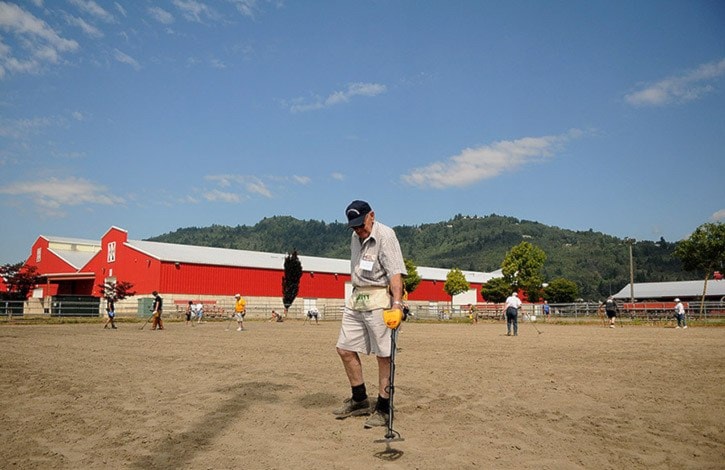Beep. Beep. Beep beep beep beep!
Carole Snider's hand shoots up in the air. "I found it!" she yells.
In her left hand she's holding a dull, dusty token. In the other she's gripping her metal detector. Snider just found a special token that has won her a silver coin prize.
She's one of more than 40 people taking part in the Fraser Valley Treasure Hunters' first annual Treasure Chest at Heritage Park on Saturday. Chilliwack's Mark Lewis is the founder of the local group which started in January and already has 45 members.
The 'hunters' at Saturday's event are from B.C., Alberta and Washington State and they're using one of the outdoor sand rings for their treasure hunt. Lewis 'salts' the turf by pelting dozens of coins and tokens into the soft, sandy ground. The coins are from different countries, and the tokens, if found, will be traded in for prizes. All the tokens have hand-written numbers and letters on them to distinguish them from the coins. Nothing of great monetary value is planted into the sand in case the hunters don't find them.
Colin Broughton from Langley has been metal detecting for 14 years. About eight years ago, he found a 78g 14-karat gold bracelet with 22 diamonds and 32 emeralds. It was appraised at $6,200. He found it in a soccer field in Ontario.
Brian Doctor of Penticton has been at it for seven years and has found coins, watches, silver, jewellery and more. He finds about $600-$700 per year in treasures.
But it's not all about the money or the thrill of finding lost items. The hunters are doing a public service to their communities by returning jewellery to their rightful owners.
"We return stuff whenever we can," says Doctor.
School rings are the most common pieces returned. It's easy to find the owner of the class rings as the person's name, school and year are all engraved on them.
A lot of the items found are old and have been buried for years, but when the hunters find something that they believe has a chance of being returned, or appears to have been recently lost, they will try to locate the owner as best they can, including searching the 'lost' ads in their local newspapers.
Sometimes people have called metal detecting clubs directly to see if a member can help them find their lost item at the location it went missing. Finding the lost item has proved successful on more than one occasion.
Like the time a woman lost her 18-karat solitaire diamond wedding ring on a beach in Penticton. She called the Penticton Metal Detectors Club and the ring was found within 15 minutes.
"It's really great to give back to the owners," says Broughton.
For more info, go to www.sites.google.com/site/fraservalleytreasurehunters, or email fraservalleyth@gmail.com.
